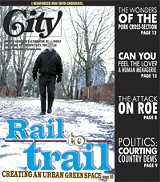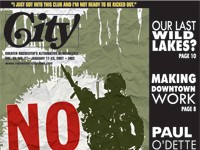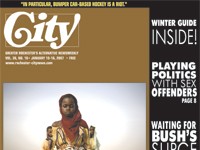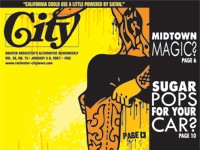[
{
"name": "500x250 Ad",
"insertPoint": "5",
"component": "15667920",
"parentWrapperClass": "",
"requiredCountToDisplay": "1"
}
]
A man and his dog have been walking along a portion of the abandoned CSX railroad track that runs parallel to Conkey Avenue and Hollenbeck Street. On this blustery February day, the pair are no longer visible, but their footprints remain etched in the snow. It is nothing but a detail, a small one at that, but for Tom Frey the frozen Nike swoosh represents the faint outline of possibility.
"You see, people do use this," says Frey, the former MonroeCounty executive. Technically speaking, people using the path right now are trespassing on CSX property; the company has removed the rail bed but still owns the land. But Frey hopes the city will buy the property some day and convert it into something he's dreamed about for more than two decades: an urban trail.
Bordered by everything from trees to gigantic billboards, this is not exactly the quintessential green space, but Frey, a Genesee Land Trust volunteer, believes that more should be done to bring nature to the city. "Most Land Trusts find that they do most of their work in suburban and rural areas," he says. "That's where open space is more available: 'Let's go out to the Town of Penfield and find out where there still is open land. Let's acquire it and get it protected before it becomes a suburban development.' Well, in the city there isn't much left like that."
"This is the first time the Land Trust --- and we've been here 16 years --- is doing something completely in the city limits," says the organization's assistant director Margaret Potter.
The Land Trust is interested in converting the abandoned railway into a paved bike trail and dirt walking path from Collingwood Drive near the Irondequoit line south to Scrantom and St. Paul Streets, just south of Clifford Avenue. If that project takes off, they will consider developing a trail along the rest of the abandoned track, which extends from HighFalls to LakeOntario. They also want to link the trail's northern entrance with trails at neighboring SenecaPark. "That's a way for this to be connected to the river trails, and that's a big thing for us," says Frey. "This is sort of the perfect combination of a river trail reaching out into the neighborhood."
But even with a narrow focus, Frey and the Land Trust face several challenges. While the proposed trail's northern and southern entrances are separated by a mere 2.25 miles, there are big differences in the demographics of those two areas. At the northern end is Collingwood, a quiet residential street with giant trees and stucco houses. Less than two miles south, loiterers appear alongside boarded-up houses and syringe-dotted lots.
"This is Conkey Avenue," Frey says as we drive parallel to the track. "Conkey has very serious problems. This is a neighborhood street that has really seen better days and has drug problems and a whole lot of other things. The trail is down behind these houses. You can see that this is not the middle-class area that that area is up north."
The abandoned track already tends to attract problems, including drug use and violence, Frey acknowledges, noting: "There was a rape a couple of years ago along the railroad bed."
Understandably then, some area residents are wary of the trail project. Some whose houses border the track at Collingwood have built fences --- two-stories high. "Kids running up here don't always make the people in this neighborhood feel comfortable, so that's been a touchy thing from the beginning," Frey says.
But Frey and some other city residents hope that converting the abandoned track into a trail might actually reduce crime there in the long run. Overgrown bushes, which currently serve as hiding places, would be trimmed or removed, and trail usage could deter illegal activity.
Outside agencies, including the Rochester Police Department, have outlined a number of safety considerations, says Frey. For example, while it might sound logical to build a fence down the entire length of the trail, Frey points out that fences both keep people out and trap them in. Similarly, intuition suggests that the trail should be well lit. But lights also encourage people to use the trail at night, Frey says. "The design basically says that you really do want lighting but you want it to be concentrated at the corners and not on the trail itself," says Frey. "If you have lighting on the trail at night, well, that means people come in."
In some ways, Frey, an attorney, former State Assemblymember, and Park Avenue area resident, himself exemplifies the bridging of class boundaries. Part of his interest in the area stems from his membership at St. Michael's Church on North Clinton Avenue --- a parish he joined more than two decades ago. Frey discovered the church on a Landmark Society tour of churches in northeast Rochester. "I saw that church and fell in love with it," he says, "and started going to church there."
From that vantage point, Frey began observing the area, and consequently the track crossing neighboring Clifford Avenue. Frey says he became interested in converting the track even before trains stopped running on it.
"I know enough about the railroad business from my days when I was the chairman of the transportation committee in the Assembly to know that these little short-line railroads don't last long," he says. "They last as long as they have customers, and the minute they lose a big customer, they tend to close. And so I've been watching this thing for a long time, knowing that sooner or later it's going to become an empty rail line."
When that happened about 10 years ago, Frey jumped into action. He called the city, the Land Trust, and the Nature Conservancy. And he pitched his idea. Some bit then, some waited a while. But now, all three are on board, with the city agreeing to fund the land purchase.
The biggest obstacle, however, has been CSX. "Dealing with the railroad is like dealing with a mule," Frey groans. "You have to hit them over the head with a 2 by 4, and that only gets their attention."
The city has been interested in the land for years, but negotiations with CSX began in earnest about five months ago. At a recent meeting with a Trail Committee formed by Frey, Paul Holahan, the city's commissioner of environmental services, said that communication between the city and CSX has been positive in recent weeks. "People are talking, and there've been phone conversations and there's been some new dialogue," he said.
While exact purchase costs are unclear, the city has authorized $1.5 million toward the purchase of three CSX-owned properties: the proposed trail land and two parcels along the river near LakeOntario. City attorney Scott Smith says he thinks the trail land will cost about half of the total.
Stalling negotiations, however, is CSX's desire to limit development along the site. Smith says the company's main concern is that using the land for anything other than the trail could open CSX up to environmental lawsuits. But the city hopes to use a portion of the land for economic development --- particularly to help Rochester Midland Corporation expand onto CSX property. As a last resort, the city could acquire the land through condemnation, Smith says. That process, though, typically costs more than a negotiated agreement.
While timelines are difficult to set, Smith says the city would like to reach an agreement relatively quickly. "We can't wait forever, because a lot of people are counting on us concluding this as expeditiously as we can," he says.
Frey remains confident that the urban trail will eventually become a reality. Kodak has donated $150,000 to the Land Trust for construction of the trail, and Frey has begun researching additional funding options, namely enhancement funds through the Genesee Transportation Council. The estimated total cost for constructing the trail: $1.5 million.
Frey says he would like construction to begin at both ends of the trail and work inward. "Our psychological reason is we'd like to have an entrance at the north end but we also want to make sure that the community in the middle of the city knows that this is something that will be done on a fair basis," he says. "And it will be an example of how it can look in both places."
Speaking of...
-
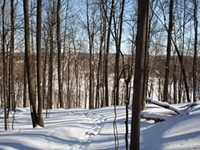
Winter Solstice events maximize light before the longest night
Dec 16, 2020 -

Calendar preview: Going shopless
Nov 25, 2020 -
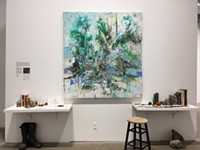
Review: 'Landscapes and the Unbuilt'
Feb 5, 2019 - More »
Latest in Featured story
More by Sujata Gupta
-

Bridging the racial divide
Nov 15, 2006 -
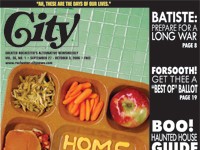
Home grown
Sep 27, 2006 -

Hiking: Happy trails
Sep 20, 2006 - More »
